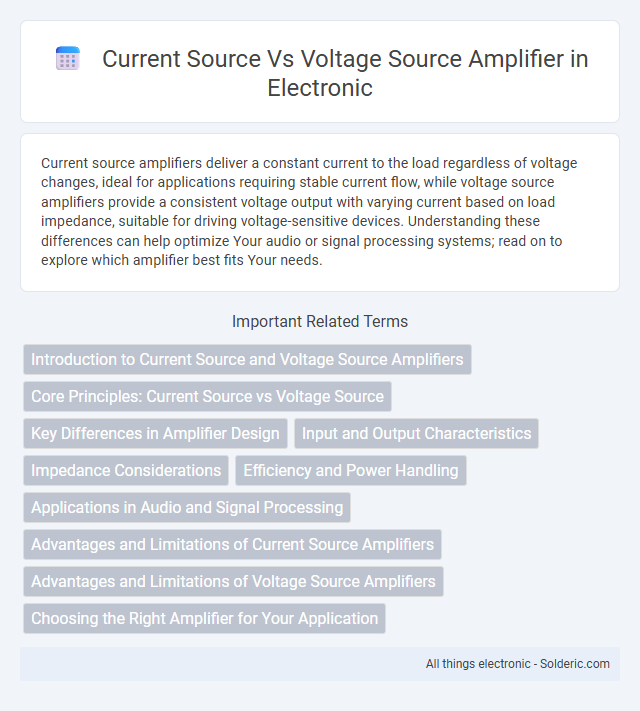Current source amplifiers deliver a constant current to the load regardless of voltage changes, ideal for applications requiring stable current flow, while voltage source amplifiers provide a consistent voltage output with varying current based on load impedance, suitable for driving voltage-sensitive devices. Understanding these differences can help optimize Your audio or signal processing systems; read on to explore which amplifier best fits Your needs.
Comparison Table
| Feature | Current Source Amplifier | Voltage Source Amplifier |
|---|---|---|
| Output Characteristic | Delivers constant current | Delivers constant voltage |
| Input Impedance | Usually low | Usually high |
| Output Impedance | High output impedance | Low output impedance |
| Typical Usage | Constant current applications, LED drivers, biasing transistors | Voltage amplification, audio amplifiers, signal conditioning |
| Load Effect | Less affected by load variations | More affected by load variations |
| Power Efficiency | Generally lower | Generally higher |
| Design Complexity | Simpler for current regulation | Simpler for voltage regulation |
Introduction to Current Source and Voltage Source Amplifiers
Current source amplifiers regulate output current independent of voltage variations, ideal for driving low-impedance loads with stable current delivery. Voltage source amplifiers maintain a constant output voltage regardless of load changes, providing consistent voltage gain and suitability for high-impedance inputs. Understanding the distinct operational principles of current source versus voltage source amplifiers is crucial for selecting the optimal amplifier in analog circuit design.
Core Principles: Current Source vs Voltage Source
A current source amplifier delivers a constant current regardless of load variations, maintaining stable current flow through the circuit, which is ideal for driving devices requiring precise current control. In contrast, a voltage source amplifier provides a fixed voltage output, adjusting current according to the load to maintain that voltage, making it suitable for applications needing consistent voltage levels. Understanding these core principles helps you choose the right amplifier type for your electronic design, ensuring optimal performance based on whether stable current or stable voltage is critical.
Key Differences in Amplifier Design
Current source amplifiers provide a constant current output regardless of load variations, whereas voltage source amplifiers maintain a constant voltage output. Current source designs typically offer higher linearity and improved thermal stability, making them ideal for applications requiring precise current control. Voltage source amplifiers are more suited for driving resistive loads with stable voltage levels but may exhibit greater sensitivity to load changes.
Input and Output Characteristics
Current source amplifiers feature a high input impedance, allowing minimal current draw from the signal source, and provide a constant current output regardless of the load variations. Voltage source amplifiers exhibit low output impedance, maintaining a stable output voltage with varying loads while typically requiring a low input impedance to ensure signal integrity. Your choice between these amplifiers depends on whether maintaining constant current or stable voltage under different load conditions is more critical for your application.
Impedance Considerations
Current source amplifiers exhibit high output impedance, making them ideal for driving loads that require constant current regardless of voltage changes. Voltage source amplifiers have low output impedance, ensuring stable voltage delivery and minimizing signal variation under varying load conditions. Your choice between these amplifiers hinges on matching the amplifier's impedance characteristics to the specific requirements of your load and signal integrity needs.
Efficiency and Power Handling
Current source amplifiers typically offer higher efficiency due to their constant current operation, which minimizes power loss across the device. Voltage source amplifiers, while better at driving varying loads with stable voltage, often dissipate more power, reducing overall efficiency. In terms of power handling, current source amplifiers excel in applications requiring consistent current delivery under fluctuating load conditions, whereas voltage source amplifiers handle power effectively when precise voltage levels are critical.
Applications in Audio and Signal Processing
Current source amplifiers excel in audio and signal processing applications where precise current control is essential, such as in noise-sensitive microphone preamps and active load circuits, ensuring cleaner and more stable signal amplification. Voltage source amplifiers are widely used in driving speakers and headphone outputs due to their ability to maintain consistent voltage levels across varying loads, delivering clear and accurate sound reproduction. Choosing the right amplifier depends on Your specific application needs, with current sources favored for stability in low-signal conditions and voltage sources preferred for power delivery in audio playback systems.
Advantages and Limitations of Current Source Amplifiers
Current source amplifiers offer precise control over output current, making them ideal for driving loads with varying resistance while maintaining consistent performance. Their high output impedance minimizes the impact of load variations, enhancing linearity and reducing distortion in sensitive analog circuits. However, current source amplifiers can suffer from increased sensitivity to supply voltage fluctuations and may exhibit limited voltage swing compared to voltage source amplifiers, affecting their use in certain high-drive applications.
Advantages and Limitations of Voltage Source Amplifiers
Voltage source amplifiers provide stable voltage output with low output impedance, making them ideal for driving high-impedance loads and ensuring consistent voltage levels. Their advantages include simplicity in design, efficient voltage regulation, and compatibility with a wide range of signal sources. Limitations arise from reduced current driving capability and potential distortion when connected to low-impedance loads, which can compromise performance in high-current applications.
Choosing the Right Amplifier for Your Application
Selecting the right amplifier depends on whether your application requires a current source or voltage source amplifier. Current source amplifiers excel in driving loads that need constant current, such as LEDs or specific sensor circuits, while voltage source amplifiers are ideal for maintaining a steady voltage regardless of load variations, making them suitable for audio or signal processing tasks. Understanding your system's load characteristics and performance requirements ensures your amplifier delivers optimal efficiency and signal integrity.
current source vs voltage source amplifier Infographic

 solderic.com
solderic.com